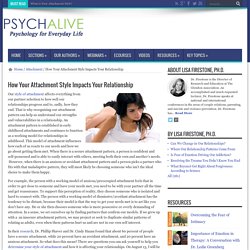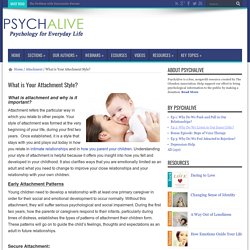

Attachment Theory in Children and Adults: Bowlby & Ainsworth's 4 Types. Attachment theory. For infants and toddlers, the "set-goal" of the attachment behavioral system is to maintain or achieve proximity to attachment figures, usually the parents.

Attachment theory is a psychological model that attempts to describe the dynamics of long-term and short-term interpersonal relationships between humans. However, "attachment theory is not formulated as a general theory of relationships. It addresses only a specific facet": how human beings respond within relationships when hurt, separated from loved ones, or perceiving a threat. Essentially all infants become attached if provided any caregiver, but there are individual differences in the quality of the relationships. In infants, attachment as a motivational and behavioral system directs the child to seek proximity with a familiar caregiver when they are alarmed, with the expectation that they will receive protection and emotional support. Infant attachment[edit] Behaviours[edit] Tenets[edit] Attachment patterns[edit] 1. 2. Notes[edit] Why Our Partners Drive Us Mad: Philosopher Alain de Botton to the Central Foible of the Human Heart and How to Heal It. “To love without knowing how to love wounds the person we love,” wrote the great Zen teacher Thich Nhat Hanh in his treatise on mastering the art of loving.

But not knowing how to be loved equally wounds us, and wounds those who try to love us. Philosopher Alain de Botton has devoted the lion’s share of his life to exploring the complex psychoemotional machinery that, despite our best intentions, inflicts the wounds of love upon us and our partners. Decades after Willa Cather termed romantic relationships “the tragic necessity of human life,” De Botton writes in The Course of Love (public library) — his stunning meditation on the fragilities of the human heart, the source of his insight into the psychological paradox of sulking in intimate relationships and what makes a good communicator: We believe we are seeking happiness in love, but what we are really after is familiarity.
Why Breakups Hit Some People Harder than Others. Why We Can Get Obsessed With People Who Don't Want Us. Is It True Love, or Is It Just Low Self-Esteem? How Your Attachment Style Impacts Your Relationship. Our style of attachment affects everything from our partner selection to how well our relationships progress and to, sadly, how they end.

That is why recognizing our attachment pattern can help us understand our strengths and vulnerabilities in a relationship. An attachment pattern is established in early childhood attachments and continues to function as a working model for relationships in adulthood. This model of attachment influences how each of us reacts to our needs and how we go about getting them met. When there is a secure attachment pattern, a person is confident and self-possessed and is able to easily interact with others, meeting both their own and another’s needs. However, when there is an anxious or avoidant attachment pattern and a person picks a partner who fits with that maladaptive pattern, they will most likely be choosing someone who isn’t the ideal choice to make them happy. In their research, Dr. Secure adults offer support when their partner feels distressed. What is Your Attachment Style? What is attachment and why is it important?

Attachment refers the particular way in which you relate to other people. Your style of attachment was formed at the very beginning of your life, during your first two years. Once established, it is a style that stays with you and plays out today in how you relate in intimate relationships and in how you parent your children. Understanding your style of attachment is helpful because it offers you insight into how you felt and developed in your childhood. It also clarifies ways that you are emotionally limited as an adult and what you need to change to improve your close relationships and your relationship with your own children. Early Attachment Patterns Young children need to develop a relationship with at least one primary caregiver in order for their social and emotional development to occur normally.
Child Psychology. Psychological Safety. Hug.
Love Harassment. Fear of Intimacy. Love Commitment. Active Constructive Communication. 5 Ways We Reject Love (and How We Can Stop) Interpersonal Psychotherapy. Ethology. Human Evolution. Eating Disorder.